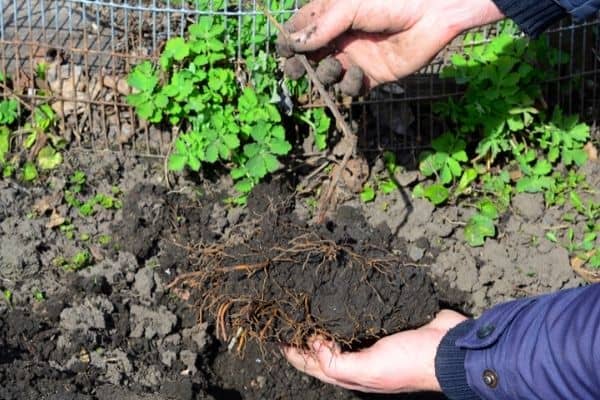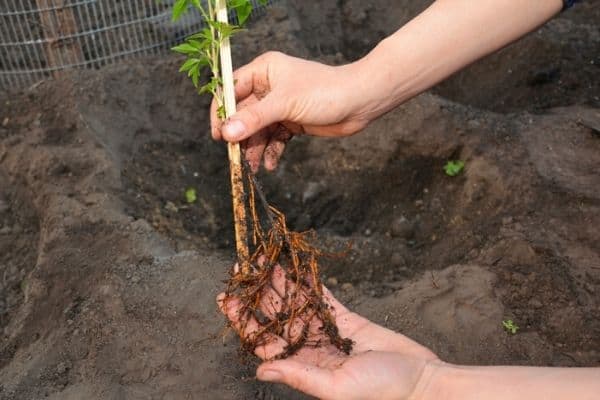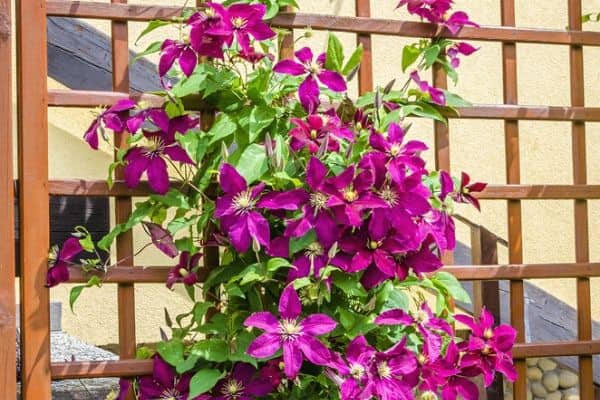A healthy clematis root system is essential for transporting nutrients and water to the plant so it can produce beautiful flowers.
In this guide to clematis roots I’ll share my tips for uprooting and transplanting clematis plants, and give you my best tips for keeping your clematis roots healthy.
This post contains affiliate links. Please read the disclosure for more info.

Clematis root structure
Clematis roots form a dense network of fibrous roots with few feeding (tap) roots.
It’s the fibrous roots that take up water and nutrients from the soil.
Clematis roots generally grow about 2 feet (60 cm) deep and wide, which also helps to stabilize the plant.
The roots of clematis plants can be damaged by too much water, which can rot and weaken the roots.
Take care to ensure that the soil is moist but not waterlogged.
Tips for uprooting clematis
If your clematis is established in a bed that you don’t want it in, or has become too large to manage, you can dig up the roots and transplant the plant to a large pot or plant it somewhere else in the garden.

Digging up roots from established plants
If you’re digging up the whole plant and transplanting it, be prepared for some hard work because many established clematises have deep roots that spread out through the soil.
The first step is to loosen the soil around your clematis so you can see how deep the roots have spread. You can do this with a fork or garden spade.
Next, clear away all of the tangled vegetation and any self-sown seedlings growing in close proximity to the main plant. Take care not to damage the plant.
Then pull out all of the circling roots and any secondary shoots growing from these roots, and use a fork or spade to pierce and loosen up the soil further so you can see where more roots are hidden.
When you see that there are no more roots left in the main clump, use a fork or spade to loosen the soil as much as possible where the roots have spread.
If any sections of roots remain, you can loosen them with a fork or spade and give them a good tug to remove the section of root completely.
Self-sown seedlings will spring up from your original clematis every year, so don’t worry about trying to get all of the roots out.
If you’ve chosen a pot that is big enough, simply remove your clematis from the ground and place it straight in its new home.
If the plant is too big for the pot, you’ll need to divide it first.
To do this, cut a circle around the base of the plant with secateurs or a pruning saw until you see where you can break off part of the root system.
Use a fork to pull out any remaining roots from this section, then continue cutting round the plant until you have divided it into sections with enough roots to support each new plant.

How to keep clematis roots cool in summer
Growing clematis plants from cuttings is relatively easy, but you need to be mindful of the temperature of the soil.
If the soil is too hot, this can hinder root growth and prevent the plants reaching their full potential.
Clematis tend to be planted deeper than most plants so that clematis wilt doesn’t affect the plant.
Ideally, the crown of the plant should be planted a few inches below the surface of the soil.
This will help the roots to grow deeper, so they can access cooler soil.
It’s also a good idea to use a thick layer of mulch around your clematis plants to help keep both moisture and temperature levels down.
Overgrown clematis roots in pots
It’s easy for clematis roots to outgrow their containers over time, so they’ll need to be repotted every few years.
To repot a clematis plant you’ll need to remove it from its existing container, and loosen the roots before replanting it into a pot about one size larger.
You may need to give the roots a trim to enable them to fit into the new pot.
Also, ensure that the new pot has a hole at the bottom for drainage so that excess water can flow away from the roots.

How deep do clematis roots grow?
Clematis roots can grow down to about two feet (60 cm) deep and the same length in width. [1]
Are clematis roots invasive?
Clematis roots can grow fairly deep but they’re unlikely to cause damage to concrete, pipes or the foundation of your house.
RELATED ARTICLES
So there is my guide to clematis roots.
I hope it helps you to take care of your clematis plants so they grow into beautiful, flowering plants with healthy root systems.
How do you care for the roots of your clematis plants? Let me know in the comments below.
Are you on Pinterest? I have boards dedicated to Garden Plants and Gardening Tips that you may find interesting. You can also find me on Facebook.






thank you, I am having to move my clematis of 15 years and reading over your instructions helped a bunch. We will see in the spring if I was successful!
Thanks Stephanie, good luck with transplanting your clematis.
Hi! I’m having the opposite problem. There’s a rogue Fortune Spindle in the bed with my clematis, and I’m having a heck of a time trying to get the one out without damaging the other. Now I’m afraid I just ripped off a huge portion of my clematis roots because they’re so similar! Any tips for telling the difference (and disentangling them safely?)
I’m trying to find the President clematis. White Flower Farms had them, however, are out of stock. Any sources that you could recommend. I have scoured all the garden centers locally and beyond. Probably 10 different places. I moved and left mine behind. I’m so upset that I can’t find this beautiful plant.
Hi Joanne, I haven’t seen any President clematis in the nurseries around here, sorry. Have you tried any of the online nurseries?
Hello Kelly, thank you for sharing your wealth of knowledge with us. Forever grateful. I was wondering would now be a good time to transplant my clematis? I have several that I would like to move,[hopefully to a better location.] Also is there a problem planting different types together?
Thank you in advance. Peace.
Elizabeth Beal
Hi Elizabeth, the best time to transplant clematis plants is early spring, just when they’re coming out of dormancy. You can plant different types of clematis in the same area without any problems.